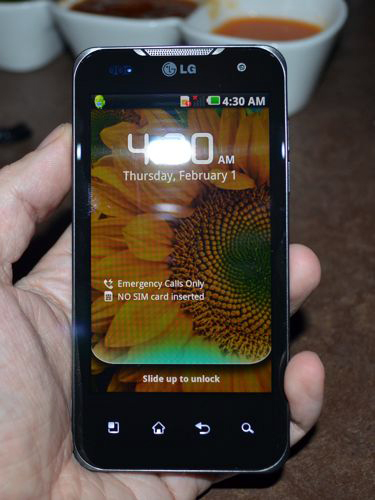
The LG Optimus 2X – the world’s first dual-core smartphone, and the LG Optimus Black – a stunning new, bright, and incredibly thin phone – were both on display at the Consumer Electronics Show in Las Vegas this week, and Sascha Segan over at PC Mag had the opportunity to spend a little time with them.
Here’s the skinny on the Optimus Black:
The Optimus Black is today’s genuinely new phone, as the Optimus 2X was announced a few weeks ago. The Black’s “Nova” display uses the same IPS LCD technology as the Apple iPhone 4, albeit at a lower 800×480 resolution on its 4-inch screen. According to LG, the display pumps out 700 nits of brightness. That comapres to 500 nits on the iPhone 4 and 300 nits on the Super AMOLED screen on the Samsung Galaxy S.
…
The Black is also the first phone I’ve seen to support Wi-Fi Direct. That’s a new ad-hoc networking protocol which will allow Wi-Fi-powered devices to find each other easily. LG is heavily interested in DLNA, the media-streaming technology, and Wi-Fi Direct here looks like a way to help phones, TVs and other devices find each other so they can share and stream media.
Other specs are standard for a high-end smartphone. The Black has a 1Ghz TI OMAP 3630 processor, a 5-megapixel camera on the back, 2GB of internal storage, and a 1500 mAh battery.
The other major phone on the scene from LG was the Optimus 2X, which had been announced a few weeks ago, but this was the first chance anyone had to get their hands on one:
I also got a few minutes with the LG Optimus 2X, the first dual-core, ARM Cortex-A9 phone. It’s a big slab smartphone that seems made for high-end gaming, but the software on the prototype I played with felt incomplete. The phone looks and feels a lot like an HTC EVO 4G or HD7, because of its 4.3-inch size and sharp bezel along the bottom.
Although it has an 8-megapixel camera and a moderately interesting, slightly hacked user interface with wallpaper previews and new widgets, the Optimus 2X’s real selling points are around what its nVidia processor can do. That means awesome video and gaming: the phone has an HDMI port that can mirror the phone’s screen on an HDTV or play 1080p HD videos, and it’s supposed to play immersive, high-def games better than any other handheld.
If you think this is all to the story, you’re mistaken – there are lots of interesting tidbits I didn’t lift, and most importantly, a slideshow of both devices are over at PCMag.com from which the photo above was taken. Head over and see what the world’s first dual-core smartphone looks like up close!
